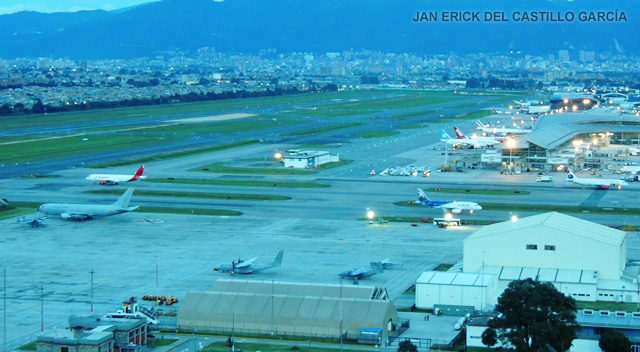Colombia"™s domestic passenger levels fell in 2017, driven in part by a pilot strike at the country"™s largest airline Avianca. But the country has posted impressive growth in its domestic air travel market during the past seven years, with passenger levels expanding by more than 60% from 2011 to 2017.
The country"™s aviation sector has changed during the past couple of years as LATAM Airlines Colombia has debuted a new pricing structure and Copa Colombia has transitioned to a low cost airline, Wingo. Those changes have occurred as Latin America"™s airlines are adapting to low cost airline growth in the region.
There"™s still much runway for passenger stimulation in Colombia"™s domestic and international markets, but similarly to many countries in Latin America, Colombia could risk jeopardising air passenger growth through a passenger fee proposed by Bogotá"™s mayor, which would levy a new tax on passengers to fund investments in road infrastructure.
Colombia’s domestic passenger growth dips, but remains solid in the long term
Colombia posted a rare 3.3% decline in domestic passenger growth in 2017, driven in part by a 51 day pilot strike at the country"™s largest airline Avianca.
The airline"™s domestic passenger numbers fell 6.4% year-on-year (according to Colombia"™s DGAC), but Avianca maintained its dominance in Colombia, holding a 58% share of the country"™s domestic passengers. LATAM Airlines Colombia"™s passenger levels were flat year-on-year, while VivaColombia grew its passengers by 2.5% to 3.2 million.
Although the smaller carriers EasyFly and Satena hold smaller shares of Colombia"™s domestic passengers, those airlines logged passenger growth of 2.8% and 5.3%, respectively.
Even as Colombia"™s passenger levels fell in 2017, passenger growth in the country"™s domestic sector has grown significantly during the past seven years. During 2011, Colombia"™s airlines transported 16 million passengers.
With Wingo"™s transition, the establishment of another Viva franchise in Peru and a new ULCC JetSMART debuting in Chile, LATAM Airlines Group has adopted product segmentation in six South American domestic markets "“ Chile, Peru, Brazil, Argentina, Ecuador and Colombia. The project began in 2017, the company offering basic economy-like fares in those markets that are 20% cheaper and projecting 50% passenger growth on domestic routes in its South American countries by 2020.
Colombia represents approximately 4% of LATAM"™s revenue-based point of sale (according to company data for the 12M ending Sep-2017), but with VivaColombia continuing to grow its market share, LATAM needs a strategy to capture passenger growth in Colombia"™s domestic market. LATAM Airlines Colombia"™s traffic grew 6.6% in 2017 on 3.3% capacity growth, and its load factor increased from 80.8% to 83.4%.
Copa"™s goal with Wingo was to transform its loss-making Colombian operations, and the company is pleased with the results. Wingo"™s operations are titled toward international operations, and Copa executives have stated that while the new low cost brand represents just 2% of its revenues, the airline"™s performance has exceeded Copa"™s expectations both financially and operationally.
With the country having a population nearing 49 million, and 26 million passengers travelling on domestic flights in 2017, there is a lot of upside for growth in Colombia"™s aviation market. Colombia"™s trips per capita in 2016 were 0.7 "“ slightly above Brazil"™s, Mexico"™s and Peru"™s 0.6 trips per capita. In contrast, trips per capita in the mature US market during 2016 reached 2.9.
But Colombian airlines could face a setback from a proposal by Bogotá"™s mayor to levy a USD2.88 tax on domestic passengers traveling through El Dorado International airport, as well as a USD5.00 fee for international passengers, to fund road infrastructure.
The Latin American airline association ALTA has warned that the move could jeopardise the competitiveness of Colombia in Latin America. The association has said that El Dorado is the third largest airport in the region, handling more than 30 million passengers per year. "Increasing the airport"™s taxes would negatively affect competition and the potential [of El Dorado] to become a regional hub compared to airports in nearby countries such as Panama", the association stated.
The World Travel & Tourism Council (WTTC), in a recent study, calculated that international spend represents 41% of Bogotá"™s tourism revenue, and has concluded that the city has a greater reliance on international visitors than several other cities in Latin America, including Buenos Aires, Rio de Janeiro, Lima, Santiago, and Brasília.
ALTA noted the success Colombia"™s government had achieved in driving benefits for the country"™s air passengers, including Aeronautica Civil de Colombia"™s role in reducing airport taxes at Cartagena in 2015. "With this tax reduction, the city of Cartagena got a great jump in air traffic and tourism development," said ALTA. "Resulting in more supply and demand, more opportunities for more people to fly, and direct benefits to Colombian economy." Cartagena"™s passenger numbers increased by 15% and 12% in 2015 and 2016, respectively…



